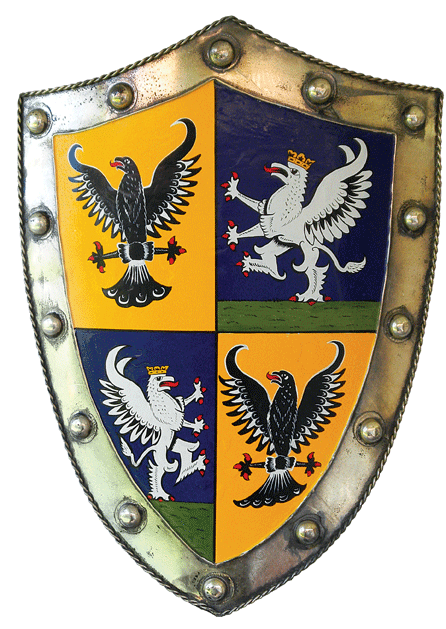How the Crusades started it all, plus historical accounts of coats-of-arms, shields, and family crests, and the meaning of colors and symbols in your family name.
- Order by phone, custom research, or have a question... Call 561-563-4103 during business hours.
-
 0
0
Origins of Heraldry:
The end of the 11th century saw the beginning of the epic Crusades (1095 A.D.) and the rise of heraldry as we know it today. Even before then, there are historical records of symbolic heraldic-type designs throughout successive civilizations.
The Japanese had the “Mon”, beautiful modernistic designs worn in three places on the Kimono of the upper classes in Japan. Servants were also required to wear the Mon of their Noblemen.
The Romans, Greeks and Assyrians also had basic heraldic emblems, “The Eagle of the Caesars” and “The Lion of Judah” being early examples. Even the Totem Poles of North American native people could be described as heraldic in form.
The magnificent Bayeux Tapestry records the Norman invasion of England in 1066. In it, many shields are depicted, showing different forms of crosses, dragons and other imaginary animals. While not proper heraldry (none of the shields are ever depicted twice), it gives a glimpse at what could be the fore-runner to true armory.
Isolated examples of proper heraldry date back to the early part of the 12th century, perhaps even the late 11th century (with the first Crusade in 1095). By the time of the third Crusade (1189), heraldic designs were fully in existence as decoration on weaponry, principally on shields.
Most heraldic scholars agree that over time, coats-of-arms became a necessity for distinction in battle. With limited means to communicate, colorful symbols became an essential means of identification. Shields were painted with symbols and animals, and helmets were adorned with feathers and decorations.
Viewed from today, the Crusades, a Christian army set on liberating the Holy Land, may seem fanatical. But from the point of view of heraldry, the Crusades brought armory to life. European Noblemen from England, France, Germany, Italy and more, joined together in a united force.
Their shields were decorated with markings to show their strength, devotion to the cause, and social standing. The fact that different heraldic symbols (and their positioning) seem to follow practically the same pattern across most European countries owes much to the Crusades.
Throughout this era, and the medieval centuries that followed, warfare was a way of life. Practically every man fought at some stage of his life. For this reason, his weapons were everything to him—his fathers’ sword, the banner his father carried into battle, the shield that was his greatest defense.
Passed down from generation to generation, soon it was not just the name that was hereditary, but also the heraldic symbols associated with it. The coat-of-arms would be proudly displayed to show the honor earned by the original bearer of the shield.
As heraldry expanded, it grew to include “arms” (coat-of-arms or family crest) awarded to families of distinction, with colors and symbols recognizing accomplishment of the family, whether they be nobility, explorers, warriors or tradesmen.
The granting of arms was considered so important, each country had an Office of Heraldry (often by royal appointment) to oversee all heraldry, assign symbols, positioning and coloring, and record each name in historical heraldry books.
It is thanks to the high office in these countries that we have accurate records of the true heraldic family crests for thousands of names today.







